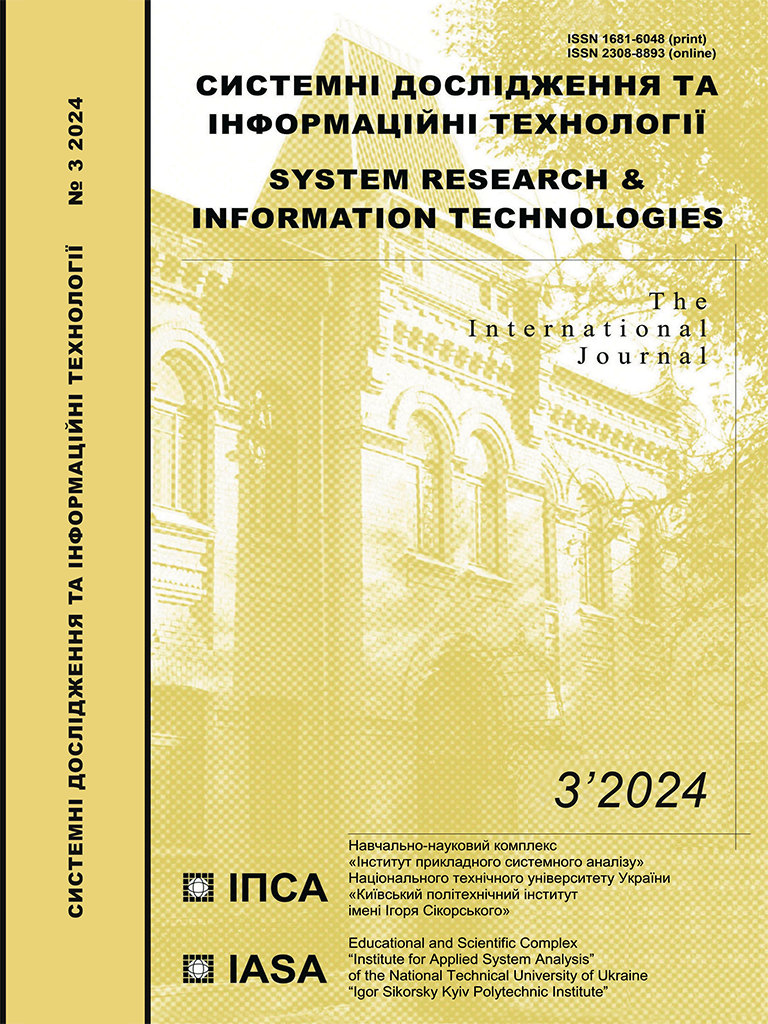Improving the accuracy of neural network exchange rate forecasting using evolutionary modeling methods
DOI:
https://doi.org/10.20535/SRIT.2308-8893.2024.3.01Keywords:
exchange rate, genetic algorithm, evolutionary modeling, neural network, optimization, forecasting, accuracy, time seriesAbstract
A set of models of feedforward neural networks is created to obtain operational forecasts of the time series of the hryvnia/dollar exchange rate. It is shown that using an evolutionary algorithm for the total search of basic characteristics and a genetic algorithm for searching the values of the matrix of neural network weight coefficients allows optimizing the configuration and selecting the best neural network models according to various criteria of their training and testing quality. Based on the verification of forecasting results, it is established that the use of neural network models selected by the evolutionary modelling method increases the accuracy of forecasting the hryvnia/dollar exchange rate compared to neural network models created without the use of a genetic algorithm. The accuracy of the forecasting results is confirmed by the method of inverse verification using data from different retrospective periods of the time series using the criterion of the average absolute percentage error of the forecast.
References
Hidayat Muhammad, Defitri Siska Yulia, and Hilman Haim, “The Impact of Artificial Intelligence (AI) on Financial Management,” Management Studies and Business Journal (PRODUCTIVITY), vol. 1 (1), pp. 123–129, 2024.
Agrawal Ajay, Gans Joshua, and Goldfarb Avi, Artificial intelligence in the service of business. How machine prediction helps to make decisions. M.: Mann, Ivanov & Ferber, 2019, 336 p.
V.V. Pryimuk, “Implementation of artificial intelligence in the financial activity of the enterprise,” Collection of scientific works of the State Tax University, 2023 (1), pp. 183–198.
B.E. Grabovetskyi, Economic Forecasting and Planning: a textbook. K.: Centre for Educational Literature, 2003, 188 p.
“Prognostics. Terms and definitions. Committee for Scientific and Technical Terminology, issue 109. M.: Nauka, 1990, 56 p.
John T. Barkoulas, Anthony G. Barilla, and William Wells, “Long-memory exchange rate dynamics in the euro era,” Chaos, Solitons & Fractals, vol. 86 (C), pp. 92–100, 2016.
Yu-chin Chen, Kwok Ping Tsang, “What Does the Yield Curve Tell Us about Exchange Rate Predictability?” The Review of Economics and Statistics, vol. 95, pp. 185–205, 2013.
A.A. Chistyakova, B.V. Shamsha, “Information technology for forecasting non-stationary time series using singular spectral analysis,” East European Journal of Advanced Technologies, no. 2/4 (68), pp. 24–30, 2014.
P.I. Bidyuk, I.V. Baklan, and V.I. Lytvynenko, Modelling and forecasting of nonlinear dynamic processes. K.: EKMO, 2004, 120 p.
A.A. Chistyakova, “Development of methods for analysing heterogeneous dynamics series based on statistical characteristics,” East European Journal of Advanced Technologies, no. 5/4 (71), pp. 35–43, 2014.
D.-E. Bastens, W.-M. Van den Berg, and D. Wood, Neural Networks and Financial Markets: Decision Making in Trading Operations. M.: TVP Scientific Publishing House, 1997, 236 p.
D. Rutkovskaya, M. Pilinsky, and L. Rutkovsky, Neural Networks, Genetic Algorithms and Fuzzy Systems; Translated from Polish by I.D. Rudinsky. M.: Hotline-Telecom, 2004, 452 p.
Andreas S. Weigend, Bernardo A. Huberman, and David E. Rumelhart, “Predicting the future: a connectionist approach,” International Journal of Neural Systems, vol. 01, no. 03, pp. 193–209, 1990.
V.V. Korneev, A.F. Gareev, S.V. Vasyutin, and V.V. Raikh, Databases. Intelligent information processing. M.: Nolige, 2000, 352 p.
L.A. Gladkov, V.V. Kureichik, and V.M. Kureichik, Genetic algorithms; 2nd ed. M.: Fizmatlit, 2006, 320 p.
V.F. Sytnyk, M.T. Krasnyuk, Intelligent data analysis (data mining). K.: KNEU, 2007, 376 p.
N.M. Kussul, A.Y. Shelestov, and A.M. Lavreniuk, Intelligent computing: a textbook. K.: Naukova Dumka, 2006, 186 p.
“Genetic Training Option,” California Scientific Software. Nevada City, CA 95959, 1996, 54 p.
19. P.I. Bidyuk, O.I. Savenkov, and I.V. Baklan, Time series: modelling and forecasting. K.: EKMO, 2004, 144 p.
S.A. Aivazyan, V.S. Mkhitaryan, Applied Statistics and Fundamentals of Econometrics. M.: UNITY, 1998, 1006 p.
I.G. Lukianenko, L.I. Krasnikova, Econometrics: a textbook. K.: Znannya Society, KOO, 1998, 494 p.
P.I. Bidyuk, O.V. Polovtsev, Analysis and Modelling of Economic Processes in Transition. K.: NTUU “KPI”, 1999, 230 p.
P.I. Bidyuk, I.V. Baklan, and V.N. Rifa, “Systematic approach to the construction of a egression model on time series,” Systemic Research and Information Technology, no. 3, pp. 114–131, 2002.
J. Johnston, J. DiNardo, Econometric methods. New York: McGraw-Hill, 2007, 531 p.
G.E.P. Box, G.M. Jenkins, Time Series Analysis: Forecasting and Control. San Francisco: Holden-Day, 1976, 575 p.
G.E.P. Box, G.M. Jenkins, and G.C. Reinsel, Time Series Analysis: Forecasting and Control; 4th ed. US: John Wiley & Sons., 2008, 784 p.
Y.P. Lukashin, Adaptive methods of short-term forecasting of time series: a textbook. M.: Finance and Statistics, 2003, 416 p.
Z. Guo, R.E. Uhrig, “Use of genetic algorithms to select inputs for neural network,” Proceedings of International Workshop on Combinations of Genetic Algorithms and Neural Networks, COGAN-92, pp. 223–234, 1992.
D. Whitley, T. Starkweather, and C. Bogart, “Genetic algorithms and neural networks: Optimising connections and connectivity,” Parallel Computing, vol. 14, issue 3, pp. 347–361, 1990.
National Bank of Ukraine. Official exchange rate of the hryvnia against foreign currencies. US dollar. [website]. Available: https://bank.gov.ua/ua/markets/exchangerate-chart?cn%5B%5D=USD (accessed 21.04.2024)
S.S. Fedin, Artificial Intelligence Systems and Data Analysis Technologies: Workshop; 2nd ed. K.: Interservice, 2021, 848 p.

